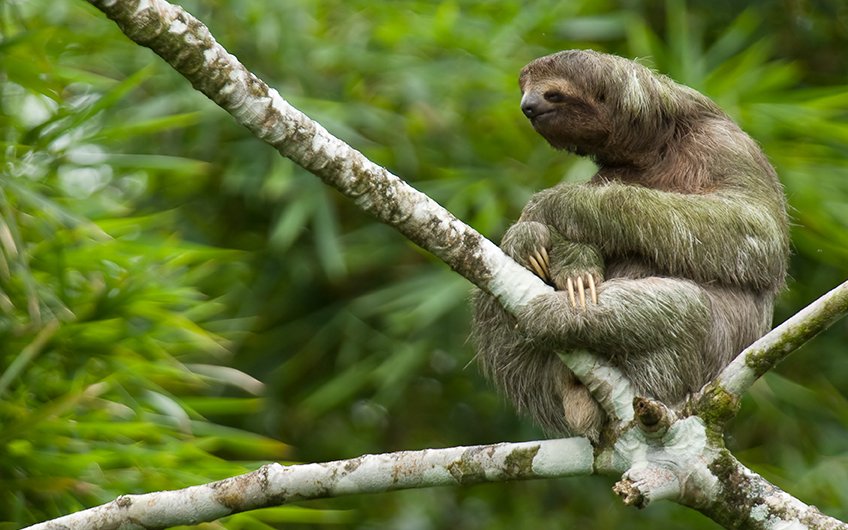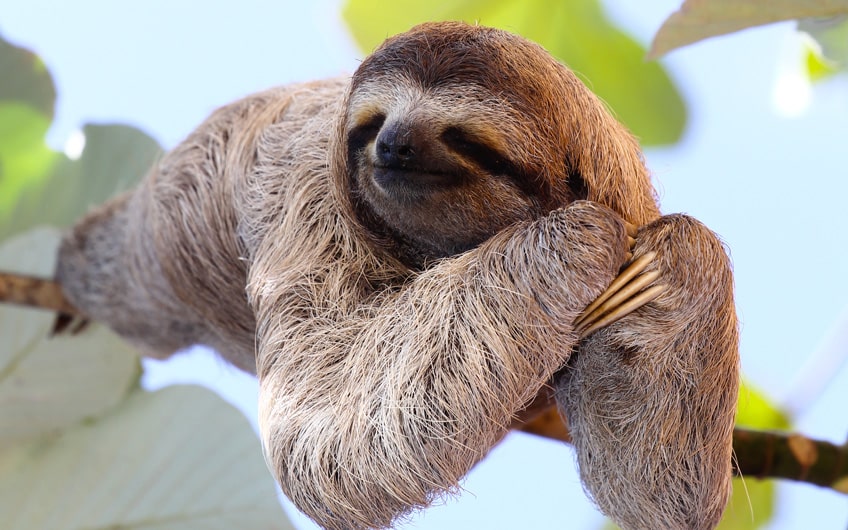
Sloths are among Costa Rica’s most iconic and beloved creatures, captivating both locals and tourists with their slow-moving charm and peaceful demeanor.
In this article, we’ll take a closer look at these fascinating animals, exploring what makes them so unique and the different species found in Costa Rica’s lush rainforests. You’ll learn about the elusive Hoffman’s two-toed sloth and the more commonly seen brown-throated sloth, along with intriguing facts about their habits and habitat.
We’ll also explore into the country’s efforts to protect these gentle creatures, highlighting the landmark Sloth Law that officially recognizes them as national symbols of wildlife conservation. Get ready to uncover the wonders of Costa Rica’s sloths and why they are much more than just slow-moving forest dwellers.
According to “The International Fund for Animal Welfare (IFAW)” a sloth is:
“Sloths are a unique kind of mammal exclusive to Southern and Central America. There are two different families of sloths—two-toed sloths and three-toed sloths.
Aside from the number of claws they have, the two types can also be distinguished via their faces. Two-toed sloths have bigger eyes and a lighter, more tousled coat, while three-toed sloths have the famous dark facial markings that make it look like they’re always smiling.
Between the two families, there are six total species of sloth. They live mainly in South America in Brazil, Venezuela, Colombia, Peru, and Bolivia. However, there are some that live further north in Costa Rica and Panama. Sloths stick to one type of habitat: lowland rainforests.
They spend the vast majority of their time in the rainforest canopies, using trees as their food and shelter.”
In Costa Rica it is possible to find two species out of the six that already exist in the world:
There are two types of sloths: the two-toed sloths and the three-toed ones. The species that can be found in our country are the Hoffman’s two-toed sloths which have two toes on the front feet and three toes on the back feet, and it is very common to watch them hanging in an upside-down position from the high branches during their daily nap. Its scientific name is Choloepus Hoffmanni.
This species of sloth is nocturnal and this makes it much more difficult to find during a tour. But, if you are lucky enough to find them during the day, be sure that these little creatures will probably (and almost surely) be napping.
The other species that can be seen in Costa Rica is the Brown-throated Sloth or the Bradypus Variegatus, for its scientific name. This is the most common three-toed sloth in the world and it is a diurnal animal. Regarding their physical appearance, you must know that they are a little bit smaller in size than the Hoffman’s sloth and also, another characteristic is that they are quite more active than the other ones.
Despite there actually six species of sloths in the world, two of them are endangered. The Costa Rica sloths are not in danger but other species such as the Brazilian and the Pygmy sloth of neighbor country, Panama, are actually endangered.
Their natural habitat is the forest, the trees specifically, where they hang out high while sleeping for about 20 hours a day. Yes, you read it right! They sleep for approximately 20 hours during the day. So, probably, when you spot one, or various of them, they will surely be taking a long nap.
Sometimes you will be lucky enough to see them outlining a smile for your camera. The forests here are varied, as they can be cloud forests like in Monteverde, or dry forests as it occurs in Guanacaste. In some areas near Costa Rica all inclusive resorts, you might even get the chance to spot these sloths in their natural habitat.
Their name has something to do with this: they move so slowly that they have a kind of algae growing on their fur, but this is not as bad as it sounds: having the fur this way serves as camouflage from the predators. Not only for their color, but also for their thick fur.


In 2021, Costa Rica further solidified its commitment to wildlife conservation with Law No. 10.007, officially declaring both two-toed and three-toed sloths as National Symbols of Wildlife. This landmark legislation aims to safeguard these beloved creatures and their natural habitats.
Former President Carlos Alvarado celebrated the sloth as a new national symbol, saying: “I celebrate the new national symbol: the sloth, the friendly and peaceful animal that is an international benchmark for animal protection.”
Former Minister of Environment and Energy, Andrea Meza, emphasized the significance of this law, stating: “Costa Rica decided to protect them (sloths) and declare them an emblematic species, as they represent a series of conservation efforts that are being developed at the national level. In addition, they are the emblem of the Stop Animal Selfies campaign, which has recognized Costa Rica as a leading country in ethical and sustainable tourism with wildlife.”
We are active members of the most important tourist associations, both national and international.
To navigate this site use a different one than Microsoft Explorer.